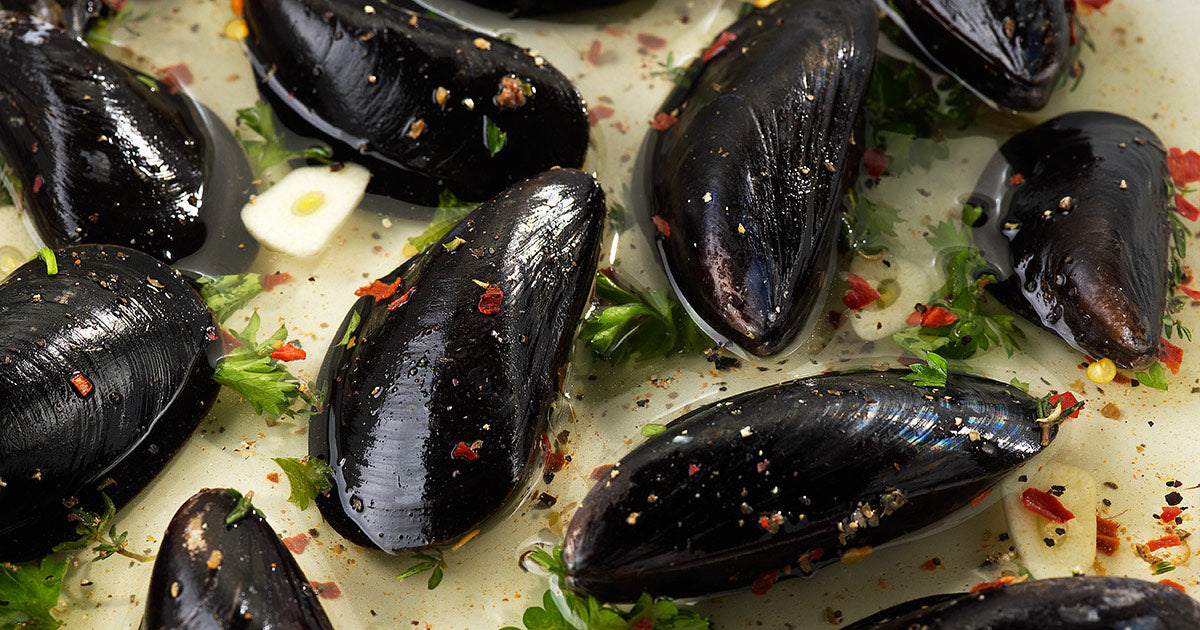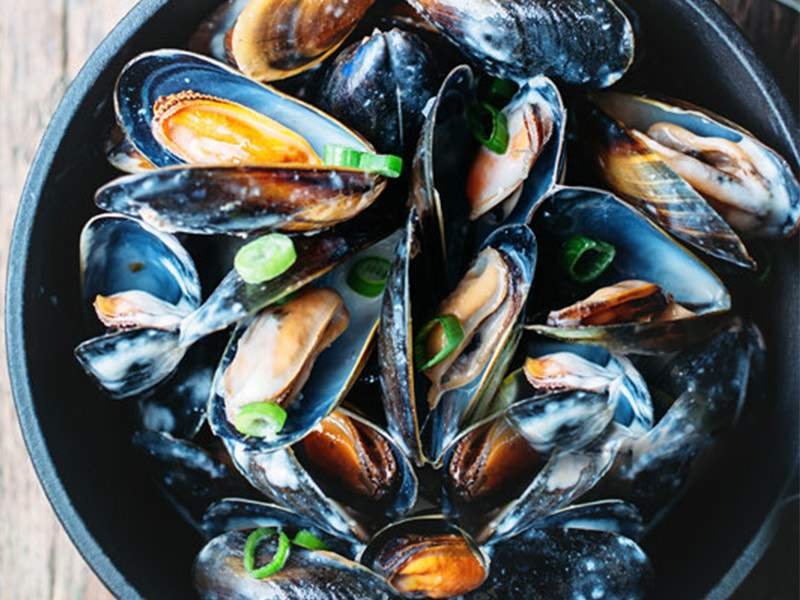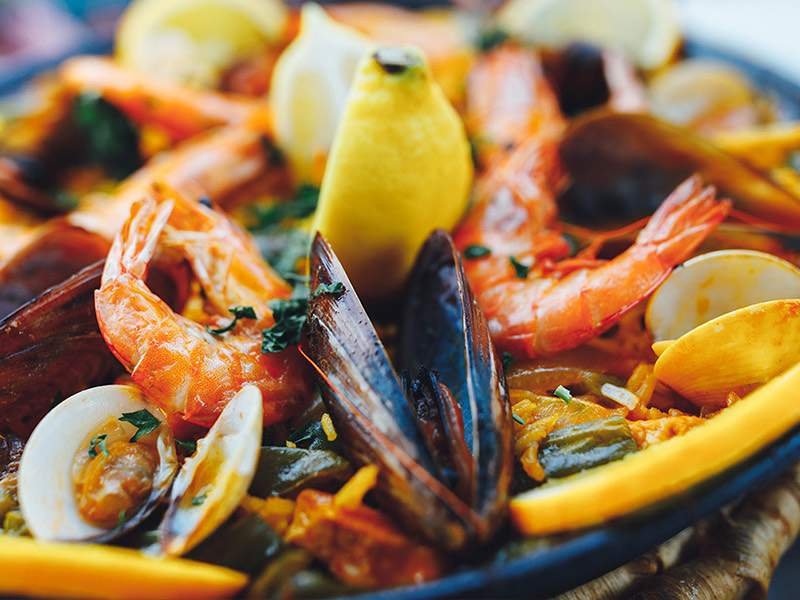Your Essential Guide to Mussels

Sustainable, healthy, affordable and delicious, there's so much to love about mussels! Get ready to flex your mussels as we dive into the world of mussels with Robert DiGregorgio, FultonFishMarket.com’s Head of Quality Control.
It’s always interesting to me how certain things - clothes, cars, even food - go in and out of style. Many popular seafood items today, such as calamari and skate, were once beloved only by certain communities. Most recently it’s been mussels. Even East Coast Native Americans, who loved clams and oysters, avoided mussels, which they thought were poisonous. Perhaps a lesson learned long in the past from eating mussels tainted from an algae bloom or some other impurities. However this belief got started, when the Europeans came to the New World they were warned not to eat the mussels, and so for the most part, mussels took a back seat to clams and oysters and were basically ignored for generations.
Not in my house though. The great surge of European immigration in the first half of the 20th century saw many people come over who were very familiar with mussels, and my Sicilian parents were among them. I think I’ve been eating mussels ever since I’ve had teeth, but how did they get so popular today? How do you mainstream something like a mussel? Well, until the 1970s and 80s, only wild mussels were available. These mussels were found clumped together on island outcrops, pilings, wherever they could gain a foothold. They were usually covered with barnacles, had tough “beards”, the byssal threads they use to attach themselves to each other or something else, and were home to little crabs, which most Americans were not going to put up with. All in all, a genuine pain in the neck to clean.
In fact, my first job in the fish business was to clean a thousand pounds of mussels a day. I was given an old fashioned can opener and told to scrape all the barnacles and beards off this huge pile of mussels. I guess they figured if that didn’t make me quit nothing would.
By the way, these “beards” are so tough and strong that a number of studies have investigated mussel glues for surgical and industrial uses, including artificial tendons.
But something great happened to mussels starting in the late 1970s. They got cultured. I don’t mean they went to charm school and took French lessons. I mean mussel aquaculture! Myticulture began in the 1970s and has gained wide practice since. There are some variations as to technique, but a common method is to fill mesh “socks” with mussel seed and suspend them vertically by rope into the water from rafts. In this way, they are safe from predators and are grit and barnacle-free. After 12-15 months they are harvested and brought to the processing plant where they are cleaned some more, graded and packed. The mussel growers that FultonFishMarket.com partner with all have state-of-the-art automated equipment doing the heavy work. The plants are immaculate and all the mussels are inspected by hand before they are packed to ensure quality.
But even wild mussels these days are handled differently. Years ago they were harvested and packed in burlap sacks as is, covered in barnacles and beards, 50-60 lbs per bag. Nowadays after harvesting they are cleaned inside and out, washed again and again in huge vats, and purged to clean them of grit and crabs. Then they are debearded by special machines as well. They are further inspected by hand, bagged, packed and iced.
What is the Difference Between Farmed and Wild Mussels?
A question we often get asked at FultonFishMarket.com is “What is the difference between P.E.I. mussels and Whitewater mussels?”
While they are both the same species, Mytilus edulis, commonly found from Virginia to Newfoundland, there are differences between them, mainly where they’re grown and how they’re grown.
P.E.I. mussels are from Prince Edward Island, Canada. They are farmed from seed to harvest, and P.E.I. has successfully been doing so since farmed mussels became popular in the 1970s. How they do it is interesting. In the springtime, when the water warms to around 55-60°F, the farmed mussels in P.E.I. spawn. The seed is accumulated by seed collectors, a frayed piece of rope or a piece of mesh. After the mussel larvae attach to the seed collector they form a hard shell and are called spat. Once the spat grow to about an inch or so, they are taken ashore, de-clumped and separated by size before being placed into mesh sleeves called socks. They are then taken back out to the farm, the socks are attached to buoys and suspended vertically in the water where the mussels grow out free of grit and barnacles and protected from predators. After about 18-24 months when they are 2¼ to 2½ inches, they are harvested.
Whitewater mussels are from Rhode Island and Maine, and are kind of a combination between wild mussels and farmed mussels. Here’s what I mean. Whereas farmed mussels are typically suspended off the bottom, Whitewater mussels are actually spread out on the bottom and are allowed to grow as wild mussels do. There are several advantages to doing this. Bottom cultured mussels have harder shells, usually have a higher meat to shell ratio, and have a more robust, wild flavor. However, like natural wild mussels, they have tough beards, and can be gritty, so to solve these problems different harvesting and processing methods had to be developed. When Whitewater mussels are harvested they are taken ashore and placed in tanks where they are purged with temperature controlled seawater to rid them of grit and bacteria. They are then mechanically tumbled, de-clumped and inspected the first time. Then, they are “shaved”, that is, run through a machine that cuts the byssal threads off at the shell. Finally, they are graded by size (medium and large), inspected by hand, bagged, tagged, iced and shipped.
With this mussel you get the advantages of farmed and wild at the same time. Both kinds are great and both have their fans who swear one is better than the other. Try them both and decide for yourself!
Are Mussels Healthy?
Another question we get asked is “Are mussels good for you?” Mussels are not only delicious, versatile and relatively inexpensive, but they’re nutritious as well. They are a good source of Omega-3s, low in fat, a good source of protein, high in iron, as well as vitamin B12, vitamin A and vitamin C.
Our Favorite Mussels Recipes
Steamed mussels are one of our go-to easy seafood dinner recipes. Once you start devouring these delectable mussels, it’s hard to stop! Steamed mussels are quick to make, healthy and ideal as a dinner for two or when you’re feeding a crowd.
Our authentic seafood paella recipe is inspired by the best paella restaurants in Spain, where rice is gently cooked with aromatic herbs, vegetables and spices, including saffron for the signature golden hue, along with the freshest seafood. Follow our easy paella recipe and be whisked away to Spain any night of the week.
The savory and briny flavor of fresh mussels is enhanced by buttery broiled bread crumbs (well, what isn’t?). You can prepare the bread crumb mixture in advance, then cook the mussels and broil when you're ready. They only take minutes under the broiler.



